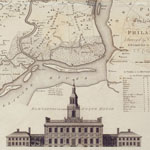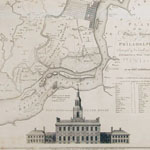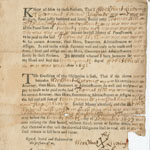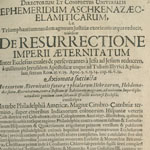
|
William Faden. A Plan of the City and Environs of Philadelphia (London, 1777). Engraved map (first state). Gift of Robert L. McNeil, Jr.
William Faden (1749-1836), geographer to the British king, based his map on the pioneering work done in 1752 by Nicholas Scull and George Heap, to whom he gave due credit. Faden did not, however, slavishly copy Scull and Heap’s work. He updated the names of the owners of the country estates surrounding Philadelphia, and he also made note of the “new fort” on Mud Island and called attention to the chevaux de fries – military landmarks of interest to a country then at war. |

|
William Faden. A Plan of the City and Environs of Philadelphia (London, 1777). Engraved map (second state). Acquired from the Jay T. Snider Collection.
William Faden’s map was reissued several times with subtle changes. This second state includes river soundings and additional references to weapons positioned on small islands in the Delaware River.
|
 |
Know all Men by these Presents. [Philadelphia: William Bradford, between 1686 and 1691.] Acquired from the Jay T. Snider Collection.
This is the only known copy of one of the first Pennsylvania imprints. William Bradford announced in his very first imprint (a 1686 almanac) that “for the ease of Clerks, Scriveners, &c. I propose to print blank Bills, Bonds, &c.” This is the only one of these early legal forms to have survived. It records a loan of £10 made by merchant Thomas Hill to Germantown joiner Weckhart Livering (or Levering) in 1691. Levering bound himself to repay the loan in two years, or else owe £20, which is what we call double indemnity. Though the form was filled out in 1691, it was probably printed in the late 1680s because the date is printed as “Anno 16 [blank].” If it had been printed in 1690 or later it would have read “Anno 169 [blank].” |
 |
Heinrich Bernard Köster. De Resurrectione Imperii Aeternitatum … conscripta in urbe Philadelphia Americae. Lemgo [Germany]: H.W. Meyer, 1702. Acquired from the Jay T. Snider Collection.
This is the only known copy of the first theological work written in Pennsylvania. The author Heinrich Köster came here in 1694 with Johannes Kelpius and his mystical Hermits of the Wissahickon, but he soon formed his own sect called The True Church of Philadelphia and wrote this theosophical, millenarian tract in 1697. Bradford did no have enough Latin to print it, so it was not published until Köster returned to Germany in 1702. The book is described in detail in Julius Sachse’s German Pietists of Pennsylvania (1895), but no copy was located until this one, which belonged to Sachse himself, was acquired at Freeman’s by Mr. Snider. |